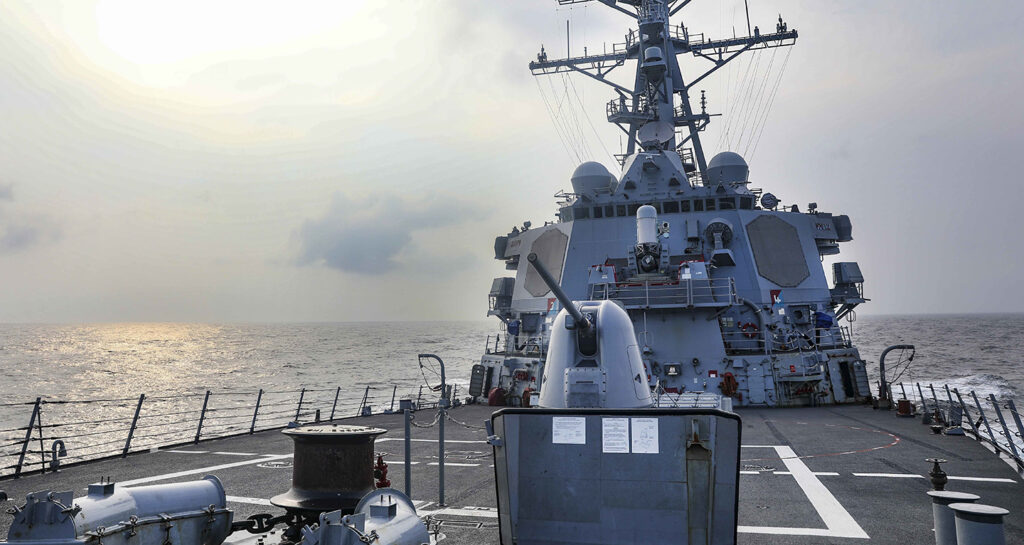The guided-missile destroyer USS Benfold was one of four destroyers dispatched to shadow a flotilla of Russian and Chinese vessels near Alaska.
THE WATCH STAFF
The United States military tracked a joint Russian and Chinese naval flotilla from the start of its more than 4,200-kilometer voyage, and U.S. destroyers shadowed it in international waters when the warships arrived off the coast of Alaska in August 2023.
This is an example of U.S. Northern Command (USNORTHCOM) with its allies and partners continuously monitoring Russian and Chinese naval activities and conducting defensive operations in the USNORTHCOM area of responsibility (AOR) and area of operational interest (AOI).
According to Air Force Master Sgt. Benjamin Wiseman, a spokesman for North American Aerospace Defense Command (NORAD) and USNORTHCOM,
“Air and maritime assets under our commands conducted operations to assure the defense of the United States and Canada,” Wiseman said in a statement to the military news website Task & Purpose. “The patrol remained in international waters and was not considered a threat.”
The concurrent U.S. action demonstrated how NORAD and USNORTHCOM can swiftly respond to potential threats to the homeland.
Experts said the warships from Russia and the People’s Republic of China (PRC) were the largest such force to approach U.S. shores, according to an August 6 report in The Wall Street Journal newspaper. Alaska’s U.S. senators, Lisa Murkowski and Dan Sullivan, said in a joint statement August 5 that they had been briefed on the flotilla and it was made up of 11 ships.
The vessels of strategic competitors Russia and the PRC are continuously monitored, tracked and contested by the U.S. military when they cross the AOR for the Department of Defense’s combatant commands. The commands are part of a globally integrated layered defense, or GILD, network that spans both geography and domains such as air, land, sea, space and cyber.
USNORTHCOM emphasizes that “out-of-area operations” by the Russian military in its AOR will be challenged in support of homeland defense.
The flotilla, which left the port city of Vladivostok in Russia’s far east on July 27, was initially monitored by U.S. Indo-Pacific Command (USINDOPACOM), where it was shadowed from July 31 by the destroyers USS Benfold and USS John Finn before responsibility transitioned to USNORTHCOM, according to reports by the websites USNI News and The War Zone.
In July, Adm. John Aquilino, the USINDOPACOM commander, told the Aspen Security Forum about the potential course of the Russian and PRC ships.
“We’ll see where that ends up, whether it’s off the Aleutian Islands … whether it goes to Hawaii or whether it goes off the west coast of the United States,” Aquilino said, according to an August 8 story by The War Zone.
The warships came close to the Aleutian Islands in August but never entered U.S. maritime territory, which stretches 19 kilometers (12 miles) from the Alaskan coastline, according to U.S. officials. The flotilla has since left, the officials said.
“This is a stark reminder of Alaska’s proximity to both China and Russia, as well as the essential role our state plays in our national defense and territorial sovereignty,” Murkowski said in the senators’ statement.
Four U.S. destroyers including USS Benfold, USS John Finn, USS John S. McCain, and USS Chung-Hoon responded to the flotilla in international waters off Alaska. In addition, the P-8 Poseidon, a U.S. maritime reconnaissance aircraft, also participated in monitoring the vessels, the Journal said.
The Russian and Chinese force was called a “historical first,” by Brent Sadler, a senior research fellow at the Heritage Foundation and a retired Navy captain, according to the Journal. Sadler also called the action “highly provocative.”
Such Russian and PRC naval exercises are becoming more common as strategic competition increases in the Arctic because the warming climate is opening the region to commercial and military activity.
Troy Bouffard, director of the Center for Arctic Security and Resilience at the University of Alaska Fairbanks, told the Anchorage Daily News that such joint operations fit a larger pattern.
“In recent years, China has been allowed to participate incredibly in Russia’s largest annual military exercises,” Bouffard told the newspaper. “Each year there’s a little bit more participation, a little bit [of] change in how they do partner and work together militarily. So, this maritime effort now is also not surprising.”
Russia’s Defense Ministry on August 4 said its vessels and those of the PRC conducted “communications training, helicopter landings and takeoffs from the decks of each other’s ships and a joint anti-submarine exercise in the southwestern part of the Bering Sea in which a mock target was detected and destroyed,” according to the Journal.
Bouffard, however, told the Daily News that the exercise is tied to Moscow’s Arctic interests as well as the war in Ukraine and the Russian desire to “demonstrate that they can still conduct force projection elsewhere in the world.”
“These are the kinds of reminders that we can’t wait for the enemy to fully engage, to start our own preparations,” Bouffard said.
The bottom line is that adversary military operations in the USNORTHCOM AOR can and will be contested. The command has the ability to conduct defensive operations in the USNORTHCOM AOR as well as the AOI at the time and place of its choosing.

